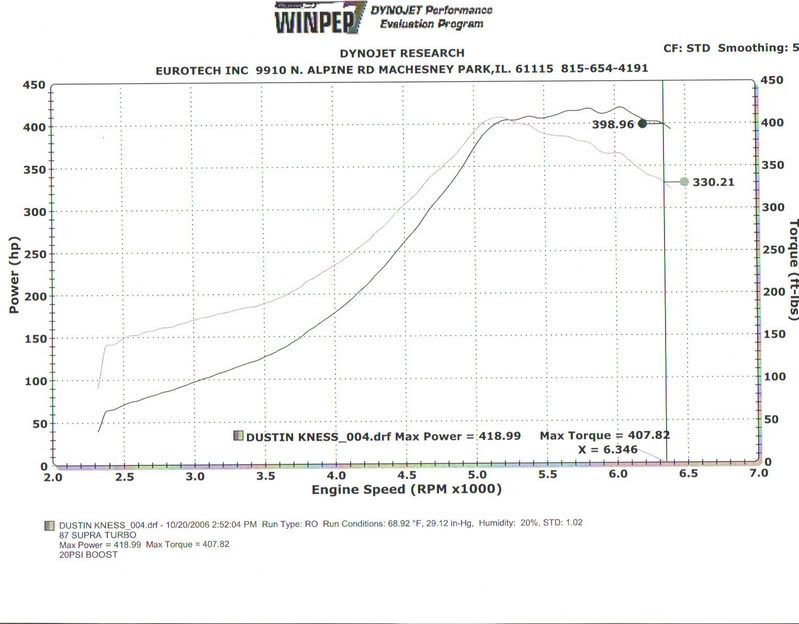Sorry to bring an old thread alive from the dead, but I can't seem to figure out why anyone hasn't bothered to correct one major nuance in both sides of this argument.
D-Dayve said:
100% VE means a 3.0L engine uses 3.0L of air over a complete cycle (2 revolutions). If you run boost, you can get say 4.0L of air into a 3.0L engine, meaning you have a VE of 133.3%. That's the way it is, plain and simple. If you don't agree with me, fine, but if you do a little research (wikipedia says: "Volumetric efficiencies above 100% can be reached by using forced induction such as supercharging or turbocharging"), and that's how I and all the tuners I've known have always understood VE. If you don't agree with me, that's fine, but it is what it is, and I can't explain it better than that.
And
DOWARD said:
Now let's say we do this your way. I'm putting just under 6.0L of air into a 3.0L motor. So 197% VE. ((191*5000))/(3456) * 2.0 * 1.97 = ~1089cfm of air.
So which is it?
I believe that you both know that it is completely impossible for a 3 liter engine to ingest any more than 3 liters of air every 2 rotations. It is not a variable displacement engine, and displacement is just this: the volume of air the engine ingests ever two crankshaft revolutions. So why use an argument that isn't backed by physics, and mucks up the point that is being made?
(also, this is why we piston heads get pissed off when rotary guys claim that they have 1.3 L engines. The 13b ingests 1.3 liters every crankshaft rotation, so in order to put into the same category as, say a 7m, it's displacement is actually 2.6 L)
We don't turn up our boost volume, we turn up our pressure. In fact pressure is not even all that useful, because heat plays a vary important role in determining density. MrWOT touched on that briefly. But again, density is only a proxy to what it is that the engine actually cares about. And what does the engine care about?
Mass. Plain and simple, any engine runs on the stoichiometric combustion of a certain mass of air(actually, oxygen, but we won't get into that) mixed with a certain mass of fuel. So what we really need to figure out is the mass flow rate of the engine. CFM is nice, but what are turbos rated in? lbs/min. Injectors in US standards? lbs/min.
Now I know, a pound isn't mass, it's force, but we're americans, and we pretend like it is mass. 1kg=2.2 lbs down here on earth's surface, and really everything should be done in kg/min, or kg/s but as long as you don't plan on tuning your can on mount everest, or mars, lbs/min is a suitable measurement.
So. you take Doward's equations to the next level, and find that the mass flow rate is the true measure of volumetric efficiency. 1lb/min = 14.472 cfm, so you can see that his engine, according to his calculations, at 97% VE (100% IC efficiency, 100% adiabatic compressor efficiency, etc...) 536cfm = 37.04 lbs/min. If his VE were 100%, he would be ingesting 38.2lbs/min.
Why does any of this matter? because at 14.7 psi gauge, (29.4 psi abs) it is completely impossible for any 3 L engine to ingest more than 38.2 lbs/min at 5000 RPM unless there is a harmonic, inertial overfilling of the cylinders in addition to the operating boost pressure.
We also care about this because it means that Doward should be running a turbo that is on its peak efficiency island when it is pushing 38-40 lbs/min of air. He should also be running cams that efficiently allow 38-40 lbs/min of air to pass through the valves when they are opening and closing almost 42 times per second. (all six cyls combined, of course)
Also, each valve is opening and closing 42 times per second. That means that the first harmonic mode, or the natural frequency of the engine at 5000 rpm is 42 Hz. This is the frequency that his intake runners and plenum should be tuned to. So a "mass packet" of air should reflect off of the back side of a closed valve, move through the runner, expand in the plenum and reflect off of the plenum wall, compress back into the runner and pick up velocity, and finally, arrive back at the valve to find it open, and not closed. All of this must happen 42 times per second at 5000 rpm in Doward's engine in order for his manifold to be tuned to the engine. All of this depends on the velocity of the air, the cross section of the port and runner, the length of the runner, and the volume of the plenum, to name just a few of the variables we're talking about here.
So the manifold controls how long it takes for the pressure wave/"mass packet" of air to get back to the valve 42 times every second. Guess what controls whether it finds an open valve or a closed valve? You guessed it, the cams. You can have a perfectly tuned intake setup, but if your cams aren't both sized right, and timed right to provide an open door when the wave returns, you won't be at peak efficiency. Physics gets you far enough to pick out the right equipment and get a base tune, and the Dyno is where the magic happens. You may not have a picture perfect setup, but any setup can be maximized to provide the best overall operating conditions, and that is where D-Dayves first comments in this thread originate from.
Again, sorry to bring a dead thread back to life over a little thing, but as you said, Doward, misinformation is bad...
-Jake


